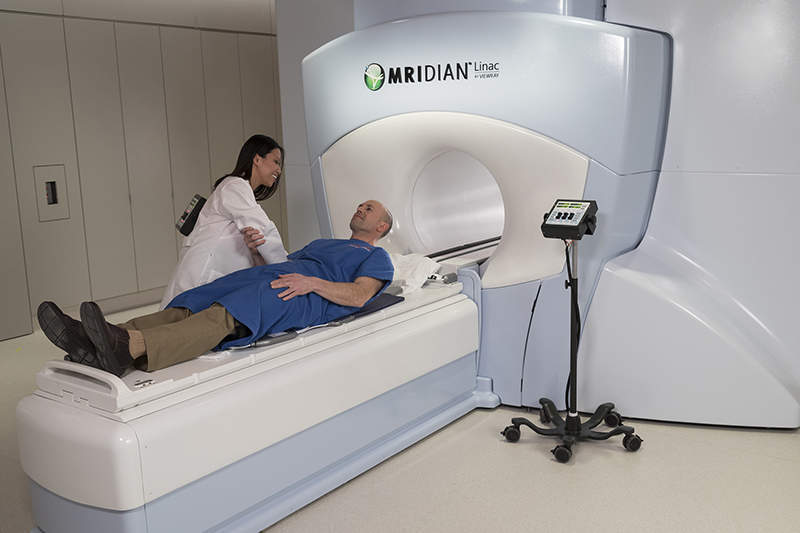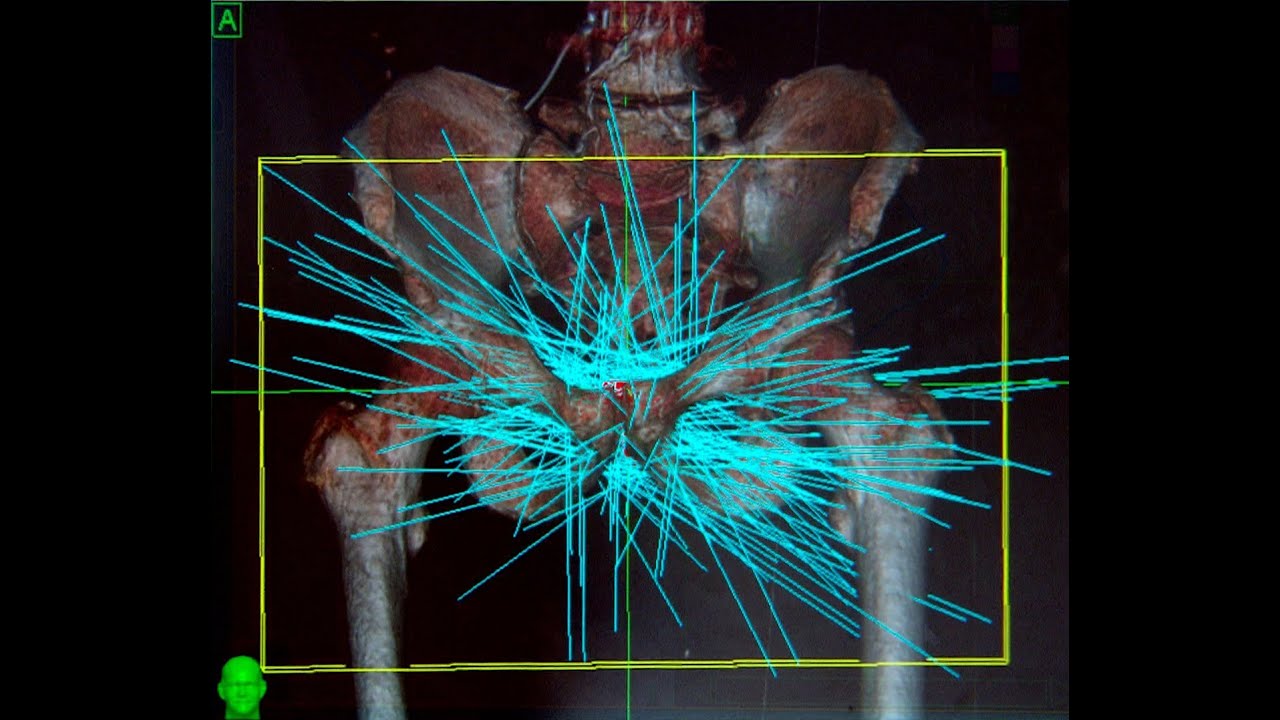Prostate matters is a not for profit organisation committed to providing free information about prostate issues from leading Clinical Authorities.
Prostate cancer treatment – Stereotactic Body Radiation Therapy (SBRT)

Overview by Dr Philip Camilleri
Consultant Clinical Oncologist
Oxford University Hospitals NHS Trust
and
Clinical Director – Urological cancers and MR Linac
Genesiscare UK

Key observation: SBRT delivers large doses of radiation per session with very great sub millimetre accuracy shortening treatment time to a few days
Other names for treatment using this technology include stereotactic ablative radiotherapy (SABR). The key difference between SBRT and Intensity Modulated Radiation Therapy (IMRT), is that it delivers the radiation with very great, sub millimetre, accuracy. Consequently, very high doses of radiation can be delivered in each treatment session reducing the number of sessions to half a dozen that can be delivered over the course of a week or two in half hour sessions, rather than taking several weeks in the case of IMRT.
SBRT delivery of very large radiation doses is a form of what is known as ultrahypofractionation.
This strategy is thought to be more beneficial for prostate cancers than other cancers. Evidence for the benefit of ultrahypofractionation exists in the form of various clinical trials, for example the HYPO-RT-PC trial run in the Netherlands (see Amsterdam trial link) compared the use of ultrahypofractionated radiotherapy over 7 fractions with conventional radiotherapy, all given on standard linac radiotherapy machines. The results showed that both treatments were identical in terms of cancer cure after 5 years of follow up, but there was a temporary slight increase in side effects with the SBRT short course of therapy.
Within the UK, the PACE-B study looked at comparing 5 fractions of treatment for prostate cancer patients with conventional therapy over 20 fractions on a standard linac. Currently the results published only show that the side effects between the two forms of radiotherapy are about the same. There is no data yet on which treatment was better although this is awaited.
A large study called a meta-analyses collected all the data published on prostate SBRT and pooled it all together to make one big mixed study containing more than 6000 patient and their data. The results show that prostate SBRT is really very effective treatment and is becoming more and more acceptable as we develop strategies that allow us to reduce the side effects of treatment considerably.
Prostate cancer can now be treated with stereotactic body radiation therapy (SBRT) using a variety of platforms and image guidance. These include:
- Linac based using conebeam CT or fiducial markers
- Cyberknife using fiducial markers
and the latest technology
- MR guided radiotherapy (MRgRT)
Linac based SBRT
This is the ability to provide stereotactic radiotherapy on a conventional radiotherapy machine called a linear accelerator. Commonly gold markers are used with this system to define the target area for the radiation. Cone Beam CT (CBCT) is an alternative method of localization of treatment targets in patients undergoing stereotactic body radiation therapy (SBRT). Patients undergo specialised CT scans whilst in an immobilization cradle to keep them still. Cone Beam CT images are obtained prior to each radiotherapy session, and registered on the planning CT by using soft tissue and bony structures to assure accuracy in SBRT delivery. Patients are repositioned for treatment based on the Cone Beam CT images.
Linac based SBRT is available in most large NHS radiotherapy centres, although the NHS has not yet made the step towards routinely using SBRT for prostate cancers as opposed to IMRT.
Cyberknife
Cyberknife, manufactured by Accuray, is another example of a Stereotactic Body Radiation Therapy (SBRT) system. In the USA, Cyberknife has been used to treat prostate cancer for the last 6 or 7 years. It is as part of the PACE trials at the Royal Marsden and is also available available privately at some centres in the UK.
However, the evidence is that it delivers no better outcome than standard Linac based SBRT. It is included for completeness.
CyberKnife uses a lightweight linear accelerator, mounted on a robotic arm, to deliver an intense focused dose of radiation to the targeted tumour. Hundreds of these tiny, high-energy radiation pulses are delivered from multiple directions. Each pulse by itself delivers only a small amount of radiation. They intersect only on the tumour with great accuracy, where the dose from the beams is cumulative and delivers intense pin-point focused radiation.
The robotic delivery system integrates motion-tracking software, called the Synchrony System, making it accurate enough to treat a moving target. When a patient breathes or moves during treatment, the robot detects the motion and the movement via the gold markers and adjusts as described above. The gold markers are inserted into the prostate by means of a separate intervention not too unlike a prostate biopsy. The markers are used to make sure the robot arm is firing the radiation in exactly the right places. X-ray images, automatically taken every 15 seconds during treatment, check that the actual location of the gold markers matches their location in the pre-treatment treatment mapping. Any changes, even very small ones are identified and if there is movement, the robot adjusts for the movement.
The manoeuvrability of the robotic arm allows multiple radiation beams from up to 1,200 different targeting positions and angles. All of the beams intersect within the tumour where the total dose is large so destroying the cancer lesion but minimizing radiation exposure to normal tissue.
MRgRT
MRgrRT also known as MR Linac or MRI guided radiotherapy, is the latest iteration of image guided radiotherapy advances. Currently two major manufacturers dominate the market although this is ever changing. Follow the link for further information on the technology.
The MRIdian by ViewRay is a very versatile MRgRT machine that marries a 0.35T magnet with a 6MV linear accelerator. Various software and hardware features produce a finely focussed beam with minimal penumbra.
The MRIdian allows a cine view of the target area to be obtained in 8 frames per second (fps) during beam on. Gating of the treatment is readily available meaning that the beam shuts off when the target moves out of the treatment area by a specified (but completely customisable) amount. This allows, not only exceptional accuracy but also incredible confidence in where the beams are going and what is happening to the target and any organs at risk near enough to be affected.
While the Elekta Unity sports a 1.5T magnet allowing greater image clarity, it has to trade this off with the distorting effect of the magnetic field. In addition, while cine views of the target can be obtained, no facility for beam gating is currently possible.
Treatment on a MRgRT machine takes around 45 minutes per session.
There are currently 33 MRIdian machines worldwide with one machine currently in the GenesisCare Centre in Oxford. Another 4 MRIdian machines are being installed in the UK at various GenesisCare centres across the UK
The MRIdian allows SBRT to be delivered to many and varied tumour sites with unparalleled accuracy. Apart from the prostate, the MRIdian is able to provide highly accurate SBRT to tumours of the lung, pancreas, liver, adrenal, spinal cord as well as lymph nodes within thorax, abdomen and pelvis.
With prostate cancer, the available data on SBRT to the prostate delivered on the MRIdian comes from the team at the VUmC in Amsterdam who published on 101 patients with prostate cancer treated in five fractions (36.25Gy in 5 fractions) on alternate days. The data supports the accuracy in so far as the side effects reported by the patients were down to a fraction of those reported by patients treated in other centres on standard linac platforms
Patient suitability for SBRT
SBRT is currently regarded as suitable for the following patients with prostate cancer:
- Those with localised prostate cancer.
- Gleason score up to 7 and higher and PSA less than 20.
- No severe urinary symptoms or recent TURP and an IPSS score of less than 20 (See link)
- Prostate volume less than 90cc
- Patients treated on an MRgRT linac will also need to be able to be scanned safely and to tolerate lying in the MR machine for up to 45 minutes each time.
Treatment and treatment planning
Prior to treatment, patients will need to have specialised scans that allow the treatment to be planned. These will differ slightly according to the platform that the patients are being treated on. For example, on the MRIdian, patients need an MRI scan done on the MRIdian itself followed by a CT scan. On the Cyberknife, and on a standard linac the patient also has both a CT and MRI scan.
Patients tolerate the treatment extremely well and are delighted that the treatment is over with in a few short sessions without much disruption to their daily life.
Side effects of SBRT
MRgRT delivered SBRT
If you have any comments about how this section on SBRT treatment for prostate cancer can be improved, please contact us.
Standard Linac delivered SBRT
Using standard Linac technology, side effects are very similar to those experienced with IMRT radiation therapy. That includes usually mild but sometimes moderate urinary problems and some fatigue a few weeks. Rarely, in about 1% of cases, patients require catheterisation for urinary retention. Because of the precision of the treatment, long-term urinary effects are unusual and rectal injury is rare. However, 20-30% patients may develop erectile dysfunction and fertility will be impaired.


Prostate matters is a not for profit organisation that is committed to providing free expert advice about prostate issues from leading Clinical Authorities
In memory of Riki
PROSTATE MATTERS
Copyright Disclaimer: We try to acknowledge copyright as appropriate. If we have used something without acknowledging copyright, this is inadvertent. Please let us know by emailing info@prostatematters.co.uk
Site design and technical development by Webtoys | Intelligent Digital Media

